The KSTR Re-Wilding Center in Quepos, Costa Rica, is a renowned sanctuary dedicated to the rehabilitation and conservation of injured wildlife. Visitors can enjoy an immersive educational experience led by knowledgeable guides, emphasizing animal welfare through a strict no-touch policy. With a 5.0 rating from over 220 reviews, the center offers an intimate look into the vital mission of restoring health to sloths, primates, and other species, ensuring a respectful connection with Costa Rica’s diverse ecosystems. Explore the center’s commitment to conservation efforts and discover why it’s become a must-visit destination for nature enthusiasts seeking an unforgettable encounter.
Key Points
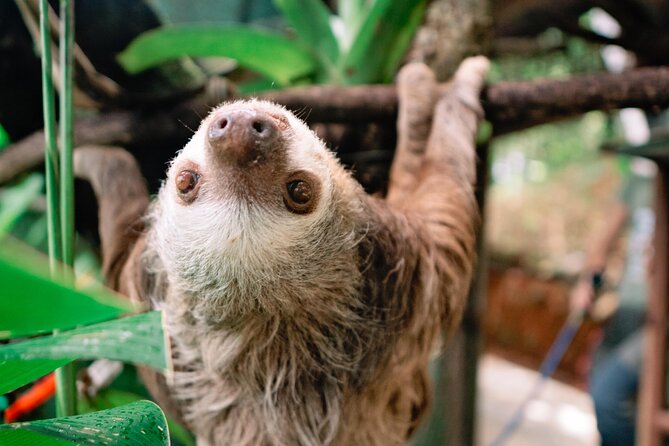
- KSTR Re-Wilding Center is a wildlife rehabilitation and conservation facility located in Quepos, Costa Rica, specializing in the care of sloths and primates.
- The center prioritizes the well-being of animals, with a strict no-touch policy, and aims to release them back into the wild whenever possible.
- Knowledgeable guides provide educational and informative tours, offering visitors an unforgettable experience in wildlife conservation.
- The center holds a prestigious 5.0 rating from 221 reviews, reflecting its commitment to exceptional animal welfare and eco-tourism standards.
- KSTR Re-Wilding Center plays a crucial role in preserving Costa Rica’s diverse wildlife and promoting long-term conservation efforts.
Overview of KSTR Re-Wilding Center
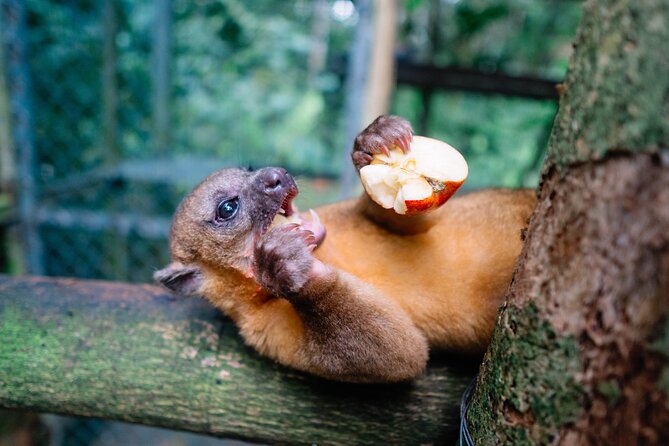
The KSTR Re-Wilding Center in Quepos, Costa Rica is a notable facility that specializes in the rehabilitation and conservation of injured wildlife, particularly sloths and primates.
Boasting a prestigious Badge of Excellence and an exceptional 5.0 rating from 221 reviews, the center stands out as a premier destination for wildlife enthusiasts and eco-travelers seeking to enjoy Costa Rica’s vibrant ecosystem.
Located in the picturesque Manuel Antonio region, the center’s mission is to provide top-notch care for injured animals, with the goal of eventually releasing them back into the wild.
Through its dedicated efforts and commitment to animal welfare, the KSTR Re-Wilding Center has earned a reputation as a beacon of excellence in wildlife conservation.
You can also read our reviews of more tours and experiences in Quepos.
Excellent Reviews and Ratings
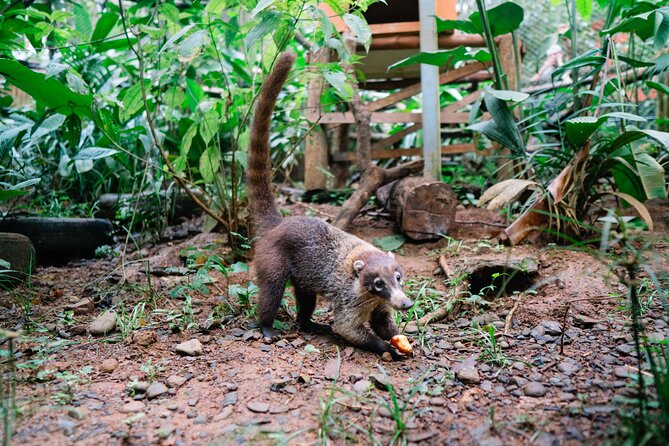
Visitors to the KSTR Re-Wilding Center have consistently lauded the facility’s exceptional standards, evidenced by its impressive 5.0 rating from 221 reviews. Travelers have been particularly impressed by the knowledgeable and informative guides, such as the highly praised Jose, who provide detailed insights into the animals and the center’s conservation efforts. The organization’s commitment to animal welfare has also earned praise, with visitors appreciating the fact that touching the animals is not allowed. The KSTR Re-Wilding Center has become a must-visit destination for anyone interested in wildlife conservation and Costa Rican ecosystems, offering an unforgettable and educational experience.
| Visitor Feedback | Highlights |
|---|---|
| Knowledgeable Guides | Detailed Animal Information |
| Conservation Commitment | Animal Welfare Focus |
| Educational Experience | Must-Visit Destination |
| 5.0 Rating from 221 Reviews | Exceptional Standards |
Tour Details and Inclusions
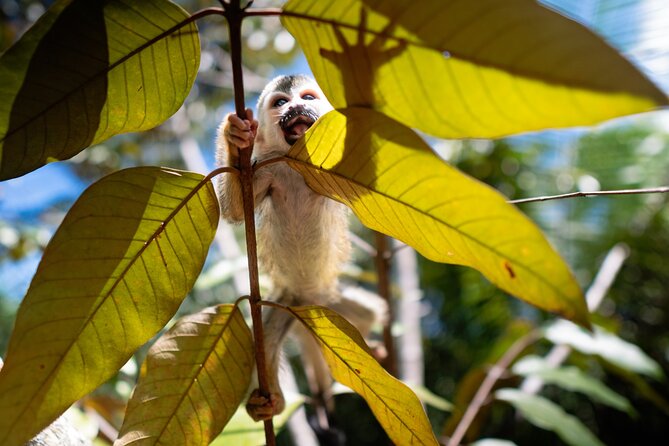
A KSTR Re-Wilding Center tour includes a selection of snacks following the experience, catering to a maximum of 25 travelers per group.
While the facility isn’t wheelchair accessible, it remains stroller accessible. Visitors receive confirmation upon booking with the option of free cancellation up to 24 hours prior to the start of the experience.
Pickup and drop-off services are available for an additional $5 per person, with the meeting point located at the Blue Banyan Inn, approximately 5km north from Finca Anita and 300 meters east in Naranjito, Costa Rica.
Detailed directions are provided on Google Maps to ensure a seamless arrival at the re-wilding center.
Pickup Information and Directions
KSTR Re-Wilding Center offers pickup and drop-off services for an additional $5 per person, with the meeting point located at the Blue Banyan Inn, approximately 5km north from Finca Anita and 300 meters east in Naranjito, Costa Rica. Detailed directions to the meeting point are available on Google Maps. Once there, visitors can look forward to an immersive experience at the center, where knowledgeable guides provide in-depth information about the animals and conservation efforts.
| Pickup and Drop-off Details | |
|---|---|
| Cost | $5 per person |
| Meeting Point | Blue Banyan Inn, 5km north from Finca Anita, 300 meters east, Naranjito, Costa Rica |
| Directions | Available on Google Maps |
| Accessibility | Not wheelchair accessible, but stroller accessible |
| Confirmation | Received at booking |
Focus on Animal Welfare
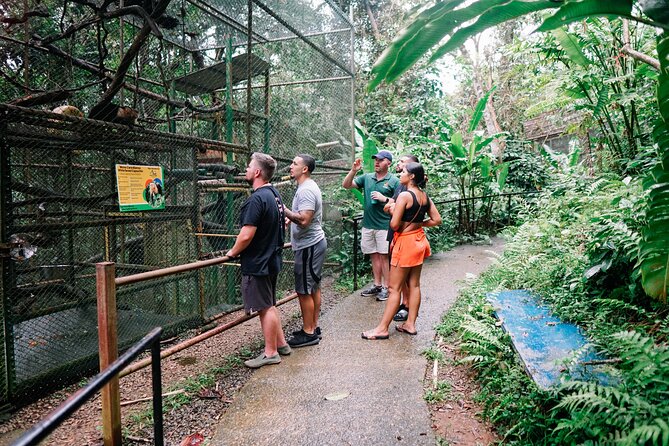
The facility prioritizes the well-being of the animals in its care, with a focus on rehabilitation and potential release back into the wild.
Some animals, however, can’t return to their natural habitats due to the nature of their injuries, and are instead provided exceptional lifelong care at the center.
Visitors aren’t allowed to touch the animals, as the center maintains a strict policy to ensure the animals’ comfort and minimize stress.
The dedicated staff closely monitor the animals’ health and behavior, providing them with a nurturing environment conducive to their recovery and long-term welfare.
Transparency and ethical practices are at the heart of the center’s operations, earning it a reputation for excellence in animal conservation and care.
Rehabilitating Injured Animals
At the heart of KSTR’s mission lies the dedicated rehabilitation of injured animals, aiming to restore their health and facilitate their eventual return to the wild whenever possible.
The center’s expert team closely monitors the animals in their care, providing specialized medical treatment and nutritional support tailored to each individual’s needs.
While some animals may be unable to be released due to the severity of their injuries, the KSTR team remains committed to ensuring their comfort and well-being within the center’s spacious enclosures.
Through this vital rehabilitation work, the center plays a crucial role in preserving Costa Rica’s diverse wildlife and promoting the long-term conservation of the country’s precious ecological resources.
Visitor Feedback and Recommendations
Visitors to the KSTR Re-Wilding Center in Manuel Antonio consistently praise the knowledgeable guides, particularly the insightful explanations provided by Jose, who offers detailed information on the animals and the center’s conservation efforts.
Reviewers appreciate the organization’s unwavering commitment to animal welfare and its focus on rehabilitation and conservation.
Many recommend the KSTR Re-Wilding Center to anyone interested in wildlife conservation and learning about Costa Rica’s diverse ecosystems.
Visitors are impressed by the center’s responsible approach, which puts the well-being of the animals first and prohibits direct interaction.
Commitment to Conservation Efforts
The KSTR Re-Wilding Center in Manuel Antonio steadfastly prioritizes animal welfare and conservation, rehabilitating injured wildlife with the ultimate goal of returning them to their natural habitats whenever possible.
While some animals unfortunately can’t be released due to the nature of their injuries, the center’s dedicated staff ensures they receive exemplary care tailored to their individual needs.
Visitors aren’t allowed to touch the animals, as the facility maintains a strong focus on the well-being of its residents.
Through its commitment to conservation efforts, KSTR plays a vital role in preserving Costa Rica’s rich biodiversity and educating the public about the importance of coexisting with the country’s diverse wildlife.
Frequently Asked Questions
What Types of Primates and Sloths Can Be Seen at the Park?
The park is home to several species of primates, including howler monkeys, spider monkeys, and white-faced capuchins. Visitors can also observe different sloth species, such as the three-toed sloth and the two-toed sloth, which are native to the region.
Does the Park Offer Any Additional Activities Besides the Tour?
The park doesn’t offer any additional activities besides the main tour. The tour focuses on providing visitors with an up-close look at the resident sloths and primates while highlighting the organization’s commitment to animal rehabilitation and conservation.
Are There Any Age Restrictions or Requirements for the Tour?
There are no age restrictions or requirements for the tour. Children of all ages are welcome to participate, though the tour may not be suitable for very young children who may have difficulty with the walking involved.
Can Visitors Take Photos or Videos of the Animals During the Tour?
Visitors are generally allowed to take photos and videos of the animals during the tour, but they must avoid disturbing or interacting with the animals. Guidelines on responsible photography may be provided to ensure the animals’ well-being.
What Measures Are in Place to Ensure the Safety of Visitors During the Tour?
The tour operator prioritizes visitor safety through strict guidelines. Visitors aren’t allowed to touch the animals, and walkways are designed with safety in mind. Staff provide thorough safety briefings and closely monitor visitors throughout the experience.
Recap
The KSTR Re-Wilding Center in Quepos, Costa Rica, is a premier wildlife sanctuary dedicated to rehabilitating injured sloths and primates.
Offering intimate educational experiences led by knowledgeable guides, the center emphasizes animal welfare through a strict no-touch policy.
With excellent reviews and a focus on conservation, a visit to the KSTR Re-Wilding Center provides an unforgettable connection to Costa Rica’s diverse ecosystems while supporting its vital mission.
More Tour Reviews in Quepos
- One-Way Private Transfer From Quepos – Manuel Antonio to the Sierpe
- Wild Savegre River Whitewater Rafting From Manuel Antonio
- Monkey Tour.
- Zip Lining Adventure From Manuel Antonio
- 4 Days Manuel Antonio Beach & San José City Short Break From Manuel Antonio
- Private Transfer From Manuel Antonio to La Fortuna From 11 to 15 Passengers
Not for you? Here's more things to do in Quepos we have recnetly reviewed
- 15 Best Canoe And Kayak Experiences In Quepos
- 2 Best Dining Experiences In Quepos
- 2 Best Dinner Tours In Quepos
- 19 Best Canoe And Kayak Experiences In Quepos
- 21 Best Cruises And Boat Tours In Quepos
- 6 Best Full-Day Tours In Quepos
- 2 Best Coffee Tours And Tastings In Quepos
- 2 Best Lunch Experiences In Quepos
- Shared 6 Hours Nauyaca Waterfall Adventure
- Private Transfer From Manuel Antonio to Nauyaca Waterfalls (Round Trip)
- Shared Shuttle From Manuel Antonio to San Jose
- Horseback Riding and Waterfalls From Manuel Antonio
